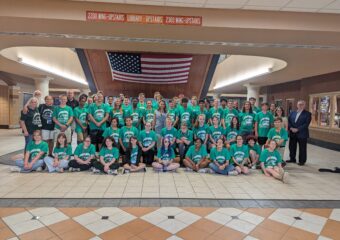ORISKANY — Oriskany Central School is deriving a plan to change the culture of the district’s learning environment to better prepare students for the careers of the future.
As part of the “Oriskany: Beyond the Box” Innovation Initiative, the district hosted an innovation symposium Thursday featuring representatives of local high-tech companies, higher education, teachers and Board of Education members. Thursday’s event was a roundtable discussion on how Oriskany can better prepare students for the expectations of innovative environments, such as those found in universities and high-performance companies.
Among the panel were guests Ryan Miller, director of the Utica thINCubator; Regan Johnson, vice president of Griffiss Institute; Franca Armstrong, dean of the Mohawk Valley Community College Rome campus; Patrice Hallock, department chair of the Utica College Educator Preparation and Psychology-Child Life Department; Rit Fuller, SUNY Polytechnic Institute vice president of Enrollment Management in Marcy; Andrew Drozd, CEO of ANDRO Computational Solutions and creator of Project Fibonacci; Tim Butcher, managing director of BNY Mellon; Anthony Macera, of the Rome Air Force Research Laboratory; and Larry Gilroy, president of Gilroy, Kernan & Gilroy Insurance Agency.
Oriskany school district Superintendent Gregory K. Kelahan said the purpose of the symposium was to begin discussions on what it means for Oriskany to be a public school of innovation.
The district needs to look at “what we can do to create innovation,” Kelahan said, adding that there will always be at least a handful of youths interested in learning about math, science and technology, but “we want all 583 of our students” to be part of the innovation plan “so that they all are better prepared for your classrooms and jobs.”
“Beyond the Box” is part of a movement that began last September to identify how the school district can market itself as one that effectively prepares children for careers and opportunities of the 21st century. Students were first introduced to the concept by being given a white box to serve figuratively as a means to encourage them to start thinking “outside the box.”
When it came time to choose one word that would best describe the future of Oriskany Central School, the district-wide consensus was “innovation” – a place where ideas are developed and students are given the resources to try new things.
Kyle Pestar, 15, is part of the Innovative Student Group which represents the student body’s opinion on how to create “an environment that is more learning-friendly,” he said.
Pestar said he would like to see a better variety in programming offered that would make students more well rounded and allow them to explore new opportunities.
Drozd, CEO of ANDRO, said Oriskany’s innovation plan can model that of a successful business by getting students to think like business people. Johnson said Griffiss institute offers the ROPES summer camp program that teaches youths how to build a company and “how to be a company.”
“It’s not about the bottom line, but how to get to the bottom line,” Drozd said. “…You have to start them” in that way of thinking “when they’re young and high school is a good age to get them started. Maturity is an important aspect of this.”
Superintendent Kelahan also asked the panel how teachers and administrators can help “teach motivation” to encourage students and give them the confidence to pursue careers in science, technology, engineering and math.
“Is that worthwhile?,” he asked.
“You should demand the students to make things — offer experiences that are different that stick in your mind,” Miller, of Utica thINCubator said. “Then you should document these things — use blogs” so students can have a shared learning experience.
“From critical thinking and problem solving, we need to look at how we can get them to know themselves better and pick up” new “skills no matter what,” Johnson added. “I think our kids today suffer a lack of self-esteem, and I think part of this is getting them to identify what they’re good at.”
Johnson also suggested that students work more collaboratively at solving a larger problem so that they learn there is more than one way of coming up with a conclusion.
“…Have kids look at things in a different way because that’s what we do in the real world, and let kids do the teaching and tell the teachers what they have learned,” she said.
Although not all students are geared toward or have the interest in becoming scientists and engineers, the majority of panel members said math disciplines and writing skills are necessary in becoming successful, even for someone who pursues a career in law or the arts.
“We need to make math more fun and interesting for our kids,” Johnson said. “They need to learn how real people bring math into their everyday lives and how to use it in real experiences.”
MVCC’s Armstrong pointed out that no one knows yet what the careers of the future will be, but giving students a diversified education will help prepare them for multiple fields. She commended the district for deriving a list of priorities to address when developing its innovation plan: Critical thinking and problem solving; collaboration; agility and adaptability; initiative and entrepreneurship; analysis and information, effective oral and written communication; curiosity and imagination; perseverance, grit and tolerance of failure; confidence/willingness to take calculated risks; and passion and drive.
“Whether you become a welder, farmer, engineer, or insurance agent — you need all these skills,” Armstrong said.



